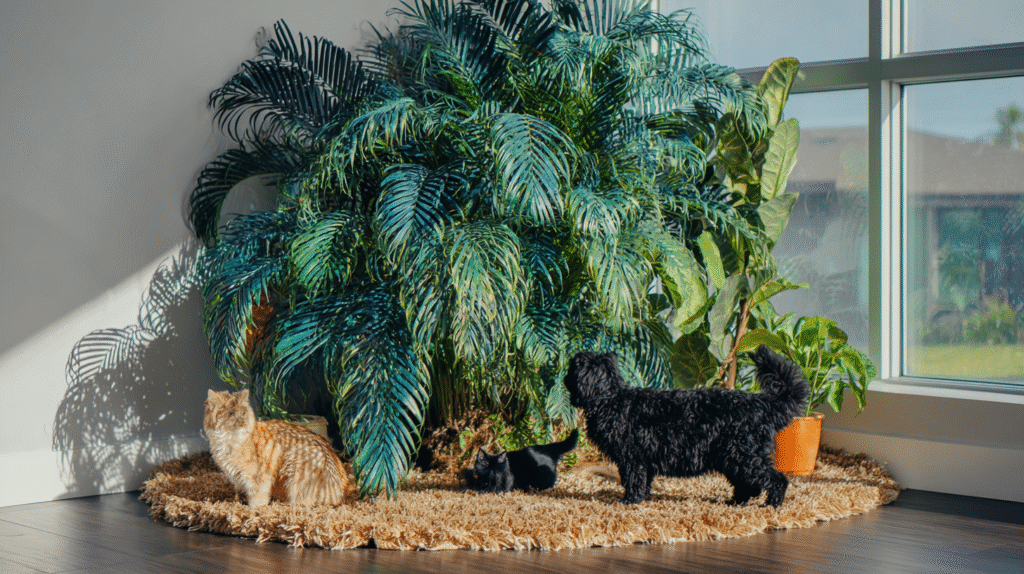My first areca palm looked like a tropical dream at Lowe’s. Three weeks later, it looked like someone had taken a blowtorch to half the fronds. Brown tips everywhere, yellowing leaves, and my confidence as a plant parent completely shattered.
That was four years and five areca palms ago. Today, I have two massive specimens that people constantly compliment, plus three smaller ones scattered around my house. The difference? I finally stopped treating them like regular houseplants and started understanding what these drama queens actually need.
If you’re struggling with brown tips, yellow fronds, or a generally sad-looking areca palm, I get it. These aren’t the easy-care plants they’re marketed as. But once you crack their code, they reward you with stunning tropical vibes that make every visitor ask, “How do you keep it so green?”
Why Areca Palms Are Worth the Learning Curve
After killing my fair share of “easier” plants, here’s why I keep coming back to arecas:
- They grow fast when happy (mine gained 3 feet in two years)
- One plant looks like an entire tropical grove
- They’re supposedly amazing air purifiers (NASA said so)
- Nothing beats that palm tree aesthetic indoors
- They’re non-toxic to pets (my cat agrees)
- They make every room feel like a vacation
My living room went from basic to “boutique hotel lobby” with just one large areca palm. That’s powerful decorating for $40.
The Watering Dance That Finally Clicked
This is where 90% of people (including past me) screw up. Areca palms are goldilocks about water – not too much, not too little, just right. Here’s what actually works:
The knuckle test: Stick your finger 2 inches into the soil. Still moist? Wait. Dry? Water time. This simple test saved my palms.
How I water:
- Thoroughly until water drains out
- Let excess drain completely (crucial!)
- Never let it sit in standing water
- Water maybe every 5-7 days in summer, 10-14 in winter
The mistakes that almost killed mine:
- Daily misting the soil (root rot city)
- Letting it dry out completely (instant brown fronds)
- Using cold water straight from the tap
I now use room-temperature water that’s been sitting out overnight. High-maintenance? Yes. Worth it for green fronds? Absolutely.
Light: The Make-or-Break Factor
Every care guide says “bright indirect light” like that means something specific. Here’s what actually works:
Perfect spots:
- 3-5 feet from an east window
- Near a south window with sheer curtains
- Bright north window (if really bright)
- Under a skylight
My lighting journey: Started mine in a dark corner because “palms like shade,” right? Wrong. Moved it to medium light – better but still sad. Finally put it near my sliding glass door with sheer curtains. Boom – new growth everywhere.
Signs you’ve got lighting wrong:
- Dark corner = yellow fronds, no growth
- Too much direct sun = bleached, crispy fronds
- Just right = vibrant green, steady new shoots
Humidity: The Secret Weapon Nobody Emphasizes Enough
This is what transformed my struggling palms into the lush beauties they are now. Areca palms want humidity like I want coffee – constantly and in large amounts.
What didn’t work:
- Occasional misting (useless)
- Pebble trays (barely helped)
- Grouping plants (minimal impact)
What actually worked:
- Humidifier running 8 hours daily
- Keeping humidity at 50-60%
- Bathroom placement for one palm
- Kitchen window for another
The $30 humidifier was a game-changer. Brown tips disappeared, growth exploded, and the fronds got that healthy shine. If you do one thing for your areca, make it humidity.

The Brown Tip Investigation
Let’s talk about everyone’s biggest complaint – those ugly brown tips. I’ve battled them all:
Water quality browns: Our tap water is full of fluoride and chlorine. Started using filtered water – 50% less browning.
Low humidity browns: Crispy and light brown. Solved with the humidifier.
Fertilizer burn browns: Dark brown and spreading. I overfed mine trying to make it grow faster. Now I use quarter-strength fertilizer monthly in summer, nothing in winter.
Natural aging browns: Lower fronds will brown and die. That’s normal. I remove them at the base with clean scissors.
Potting and Soil Secrets
Killed an areca with regular potting soil that stayed soggy. Here’s what works:
My mix:
- 50% quality potting soil
- 25% perlite
- 25% orchid bark
- Handful of charcoal
Pot choice matters:
- Plastic holds moisture (careful with watering)
- Terra cotta dries fast (more forgiving)
- Must have drainage holes (non-negotiable)
When to repot:
- Roots circling the drainage holes
- Water runs straight through
- Growth has stopped
- Every 2-3 years typically
Pro tip: Areca palms like being slightly root-bound. I waited too long to repot my first one, but the second thrived being a bit cramped.
Pest Problems I’ve Conquered
These palms are pest magnets. Here’s what I’ve dealt with:
Spider mites: Tiny webs, stippled leaves. Shower the whole plant monthly as prevention. Neem oil for treatment.
Scale: Brown bumps on stems. Rubbing alcohol on a cotton swab, then neem oil spray.
Mealybugs: White cotton-looking bugs. Same treatment as scale. Check where fronds attach to stems.
Prevention is everything. Monthly showers and checking while watering catches problems early.
Pruning: Less Is More
I used to hack at brown fronds constantly. Big mistake. Now I:
- Only remove completely brown/yellow fronds
- Cut at the base with sterilized scissors
- Never trim brown tips (makes them brown faster)
- Remove fronds pulling away from stems
- Leave partially green fronds alone
Over-pruning stressed my palm so badly it didn’t grow for months. Now I’m hands-off unless a frond is totally gone.
The Growth Journey
Year 1: Survival mode. Lost many fronds, learned about humidity, figured out watering. Growth was slow but steady.
Year 2: Hit its stride. Proper humidity and care led to explosive growth. Gained 2 feet, filled out beautifully.
Year 3: Needed dividing. What started as one palm was now three separate plants in the pot.
Year 4: Living its best life. Minimal brown tips, constant new growth, looks like a magazine photo.
Propagation: Free Plants Forever
Successfully divided my monster areca last spring. Here’s how:
- Water thoroughly the day before
- Remove from pot (this is messy)
- Gently separate root ball sections
- Each section needs roots and several stems
- Plant immediately in fresh soil
- Keep extra humid for 2 weeks
Started with one $40 palm, now have five plants worth $200+. Not bad for some dirty work.

Troubleshooting Common Problems
“My fronds are yellowing!”
- Check for overwatering first
- Then underwatering
- Might need nutrients (pale yellow)
- Could be too dark
“New growth is pale!”
- Needs more light
- Possibly iron deficiency
- Young fronds are naturally lighter
“It’s not growing!”
- Check roots (might be bound)
- Increase humidity
- More light usually helps
- Be patient – they grow in spurts
Why My Areca Palm Obsession Continues
Four years ago, I was ready to give up on palms entirely. That first crispy disaster made me feel like a plant serial killer. But something about those graceful fronds kept pulling me back.
Now, my home feels like a tropical retreat. The largest areca is my pride and joy – 6 feet tall, lush green, and constantly putting out new growth. Friends ask for care tips. My mom wants a cutting. The transformation from brown-thumb disaster to palm paradise feels pretty amazing.
Are they fussy? Absolutely. Do they require more attention than a pothos? Definitely. But when you nail the care, no other houseplant creates the same dramatic impact. One healthy areca palm can transform a room from ordinary to extraordinary.
My advice? Get one. Accept that you’ll probably struggle at first. Brown tips aren’t failure – they’re learning opportunities. With proper humidity, careful watering, and good light, you’ll have your own indoor paradise within a year. Just maybe start with a smaller one than I did. Those 6-footers are gorgeous at the store but humbling when half the fronds turn brown in your living room. Trust me on that one. 🌴







